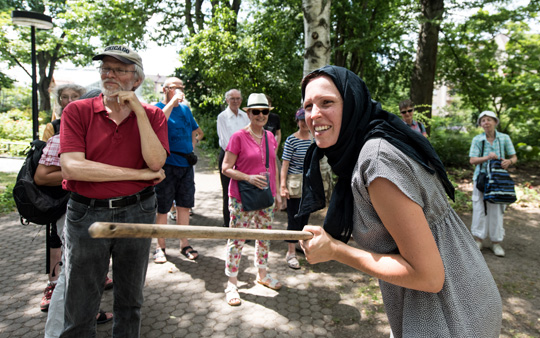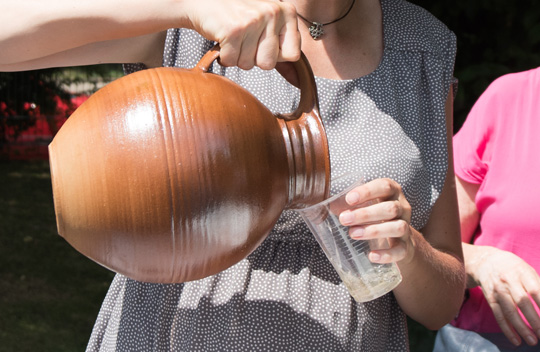Good spirits clad in green
Freiburg, Sep 14, 2017
Guided tours of the Botanic Garden have been offered by the association of friends and sponsors of the Botanic Garden of the University of Freiburg for more than ten years now. Up to four times a semester, biologists roam the grounds and glasshouses with guests.
 Dressed as a witch the biologist Henriette Gruber shows a tour group of the Botanic Garden the benefits to health that can be obtained from blossoms and leaves.
Dressed as a witch the biologist Henriette Gruber shows a tour group of the Botanic Garden the benefits to health that can be obtained from blossoms and leaves.
Photo: Patrick Seeger
A blazing hot afternoon at the Botanic Garden. A crooked old dame stands beneath a birch tree, a black scarf over her head. Turning her besom she pokes the stick towards the elderly man standing before her. "The birch emanates a powerful magic, a protective magic," she whispers.
A brief silence, then a grin passes over the faces of everyone present. The old dame straightens up, removes her headscarf, revealing the dyed red hair of Dr. Henriette Gruber, a young woman in a silky summer dress. She laughs heartily and explains, "The birch had a spiritual significance back in Germanic mythology. But you can drink a tea of birch leaves or birch juice as an excellent treatment for cellulite and swollen legs."
A group of thirteen Freiburgers has gathered under the leadership of the biologist for the 'Witches, Ghosts and Genetics' guided tour on medicinal plants and science. These guided tours of the Botanic Garden are a tradition. For Gruber it's her premiere: in real life she is a tutor at the Freiburg University of Education, but today she is playing the part of the wise woman.
Taste, smell, feel
Gruber pours a delicate yellow liquid from a stone jug into plastic cups and hands it round. "So, what can you taste?" An elderly lady wearing a pink blouse, string of pearls and summer hat pipes up, "It smells and tastes of elderflower." The others agree. "That's right," says Gruber. "The elder is one of the most magical plants. It is inhabited by good spirits. But never hang a branch of elder above a child's cot, or the fairies will get it." How serious Gruber is with such practical tips is hard to say. Medicine and magic are very closely related. Take the elder: it is diaphoretic – it induces sweating – and strengthens the immune system. "But that hasn't been scientifically proven."
 Delicate yellow, sweet and fragrant: a drink of elderflower and lemon balm tickles the taste buds of participants.
Delicate yellow, sweet and fragrant: a drink of elderflower and lemon balm tickles the taste buds of participants.
Photo: Patrick Seeger
The group proceeds to the sensory garden, where oregano, bay and sage give off a beguiling scent. The participants feel the furry leaves of sage and then smell their hands. "It's great for sweaty feet," explains the biologist. "That's the result of thujone, an essential oil. Its effect was long known before people spoke of witches and wizards. But be careful! Never drink too much sage tea, because if you do thujone has a toxic effect." Three or four cups a day are okay, but not more.
Mind-expanding and delicious
Another herb that can be found in every kitchen cupboard has unimagined powers, "Bay is mind-expanding, but only if you burn it, not if you stir it in your spaghetti sauce," Gruber reports. "The priestesses of the Oracle in Delphi slept on laurel leaves and inhaled the smoke from burning bay and laurel, to foretell the future."
Yarrow on the other hand is a rather boring plant from a witch's point of view. "It has no special magical powers," says Gruber, starting to move on to the next plant. But an elderly man contradicts her, "Until the 20th Century they used to hang yarrow in the window in the forests of Bavaria, to keep the plague from the house." Konrad Müller is an expert on the plague and has already written many books on the Black Death. He knows enough to give at least one guided tour of the Botanic Garden.
To conclude the tour Gruber wants to cast a spell herself, and so she has brought a blend of herbs with her that are traditionally burned at midsummer in mid-June. The longest day of the year is a mystical date which was celebrated with feasts by the Germans and the Celts. Gruber burns oak bark, sage, mugwort, fleabane, frankincense and myrrh in a small metal bowl, a blend that is supposed to capture the energy of the sun and attune one to the second half of the year. In addition, the dried leaves and crumbs of resin protect travelers from impending disaster. "This passes the energy of the herbs to us," explains Gruber, "Today you go home purified and with the maximum of protection."
Sonja Seidel
Discover the Botanic Garden
There is an autumn walk with head gardener Dirk Rohleder at the Botanic Garden on 23rd September 2017. Meet at the main entrance of the Botanic Garden, Schänzlestraße 1, 79104 Freiburg, at 2 p.m. Admission costs EUR 3.00. Children and teenagers aged up to 16 can take part free of charge. No need to register.
www.botanischer-garten.uni-freiburg.de/freunde-und-foerderer

